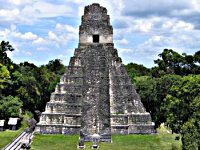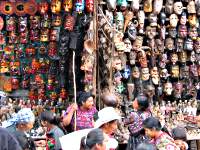Mayan History of Guatemala
All over Guatemala are vestiges of cultures that flourished before the arrival of the Spanish. In the pacific lowlands are great sculptures of animals and massive stone heads. In the highlands stand the ruins of ceremonial and defensive cities. Spreads across the jungles of the Petén are Mayan centers so numerous that they are still being discovered.
The Maya had a system of hieroglyphic writing, and though most of the characters are still undeciphered, the date glyphs, as well as intensive excavations of Mayan ruins, give some idea of their history and way of life.
Of the cultures that arose in what is now Guatemala, it was the Maya who lasted the longest and left the most traces. The Maya developed at more or less the same time as the Toltec, Olmec and Mixtec in other parts of Mesoamerica. The Maya shared many beliefs and practices with these other peoples, and borrowed some of their achievements.
Construction techniques were of the most rudimentary kind. The Maya did not use the wheel in any practical way, so the tons of rubble fill for the pyramids and platforms had to be carried on the back of humans.
After hundreds of years of development, the great Mayan cities of the Petén went trough a sudden period of sharp decline, starting in the ninth century A.D. Nobody knows why, but speculation brings up war, revolt, drought, epidemic and exhaustion of the land as some of the possible causes.
The highland nations of Guatemala were almost continuously at war with one another. Unlike the Maya and the people who had inhabited Tikal, they build their cities in inaccessible locations surrounded by ravines. From these fortified capitals, they ruled over their own territories and those of subject nations.
The principal nation of pre-Conquest Guatemala was the Quiché, sometimes called the Maya-Quiché. The name of this people means "many trees," taken perhaps from the forested highlands which they inhabited. They occupied the area running from the present town of Chichicastenango westward past Quetzaltenango. Their capital was Kumarcaj, which the Spanish and their Mexican Indian allies called Utatlán.
The Quichés have left one of the few Indian documents to describe their history before the Conquest. The Popol Vuh, the sacred book of the Quiché nation, was set down in the Quiché language using the Roman alphabet a few years after the Conquest. In a form and tone that bring to mind the Christian Bible, it tells of the creation of the world, and of the wanderings of the ancestors of the Quichés from a place called Tulán. There is good evidence to indicate that this Tulán was the Toltec Tula, which was shaken by internal struggles just a few years before the Quiché appeared in highland Guatemala around the year 1000. The migrants may have integrated with the inhabitants of the area and adapted their language.
Closely related to the Quichés were the Tzutuhils and Cakchiquels. The Tzutuhils, "flower of nations," lived along the southern shores of Lake Atitlan, and had their capital at Chutinamit, a hill at the base of the volcano San Pedro. They controlled much of the nearby fertile coastal lowlands. The Cakchiquels originally settled around Chaviar, where Chichicastenango now stands. But when war broke out with the Quichés, they set up a new capital at Iximché, near the present-day town of Tecpán, Guatemala.
Among the other pre-Conquest nations of the highlands were the Man, with their capital at Zaculey in northwest Guatemala; the Pokomchí, of what is now Verapaz, the Poloman, who had their capital at the site known today as Mixco Viejo, and a number of lesser tribes. As with the Quiché, Cakchiquel and Tzutuhil nations, their societies were highly stratifies. A ruling class of nobles and priests dressed in royal finery ruled from a ceremonial center, while farmers and laborers grew the food and toiled at construction. At different times in the Pre-Conquest period, one nation would gain the upper hand in warfare, and subjugate another.
This situation was perfect for the Spaniards. With a minimum of diplomacy, they could use one Indian nation as an ally in a war of conquest against the others, and then in turn upon it and destroy its ruling class.
Mayalandia Tours
Mayalandia Tours
Antigua, Guatemala
Email: info@mayalandiatours.com
Phone: (+502) 4564-5535

